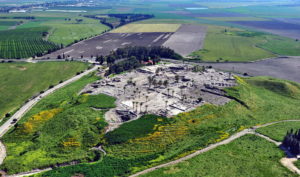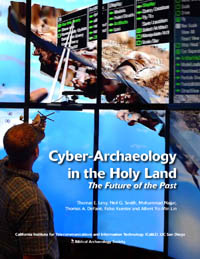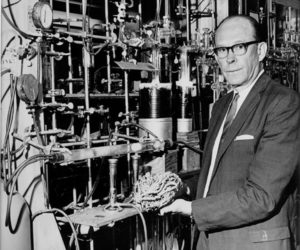What is Radiocarbon Dating?
Biblical Archaeology 101: Exploring Absolute Dating in Archaeology
Nathan Steinmeyer May 06, 2022 0 Comments 55 views


Aerial view of Tel Megiddo, a site in which radiocarbon dating is now frequently used to date archaeological levels and features. AVRAM GRAICER, CC BY-SA 3.0, via Wikimedia Commons
One of the most powerful tools in the modern archaeologist’s toolkit is radiocarbon dating, but what is radiocarbon dating in the first place? In short, radiocarbon dating is a technique to measure the amount of carbon 14 (C14) isotope present in an organic sample (a seed, bone, or even piece of wood) to estimate how long ago that sample died or began to decompose. This is one of the most powerful methods of establishing an absolute chronology for an archaeological stratum or artifact and is a necessary tool for nearly all archaeologists. However, given how critical radiocarbon dating is to many scholarly debates in biblical archaeology, it is important to know just how radiocarbon dating works, what are its limitations, and how it impacts our understanding of the past.


There are two main methods that archaeologists use to date artifacts and levels (or strata) from archaeological sites. The first are relative dating methods such as stratigraphy, typology, and even linguistic analysis of texts. However, as the name implies, these methods only provide a date relative to other artifacts or sources of data and are, therefore, rarely able to provide archaeologists with specific chronological information. The second type of dating method is absolute dating. An obvious example is an ancient text that gives the specific year in which a building was constructed. Unfortunately, these sorts of textual clues are exceedingly rare in antiquity, and instead, archaeologists turn to more scientific techniques. The most powerful of these is radiocarbon dating, but what is radiocarbon dating and how do archaeologists use it?
What Is Radiocarbon Dating? The Practice
For archaeologists to properly date something using radiocarbon dating, they must first discover something made from or containing an organic material. This could be bones, charcoal, woolen textiles, or even ancient seeds. Once organic materials have been identified, archaeologists must quickly place the find in an appropriate container to reduce the chances of contamination. Then the sample is sent to a specialized lab that can run the appropriate tests. These tests return an estimate of the age of the sample within a margin of error.
However, this is not where the story ends. Beyond being able to date the sampled material to a specific date, the chronological information can then be used help date surrounding architectural features and archaeological finds. Unfortunately, this is rarely a straightforward process and can sometimes introduce further errors into establishing a site or layer’s absolute date (discussed below). Once a relationship has been established, however, it is possible to estimate the date of a wide range of archaeological discoveries based on the dating of the sample, including the date of a building’s destruction, the period during which a site inhabited, and more.
What Is Radiocarbon Dating? The Science
Knowing the uses of the technique, however, does not answer the question, “What is radiocarbon dating?” Radiocarbon dating is a technique that estimates the exact age of organic materials based on the amount of C14 isotope present in the sample. An isotope is an atom with an abnormal number of neutrons in its nucleus. In the case of C14, it has two additional neutrons compared to the standard carbon 12 atom. As a result, C14 is unstable and breaks down over time at a predictable rate. All living things contain trace amounts of C14. This isotope is constantly being replenished throughout an organism’s life. C14 is created in the earth’s atmosphere by the bombardment of subatomic particles. These C14 atoms then rain down on the earth to be absorbed by plants during photosynthesis and then by animals higher on the food chain. However, once an organism dies and begins to decompose, this carbon can no longer be replenished and begins to break down. Knowing at what rate C14 breaks down, it is possible to examine the amount of C14 that is still present in a sample and use that to reach a very accurate estimate as to how long ago that organism died (but always with some level of error, as discussed below). These data can then be converted into dates within a particular calendrical system to provide an estimate of the material’s age.


American scientist Willard Libby who helped lead the effort to develop radiocarbon dating. Rredondo99, CC BY-SA 4.0, via Wikimedia Commons
There are several different methods used by laboratories in estimating the amount of C14 left in a sample. The traditional method involves measuring the trace amount of radiation given off by the carbon atoms. New equipment that uses this technique can date material that weighs as little as a tenth of an ounce. An increasingly dominant technique, however, is accelerated mass spectrometry, which can measure the number of C14 atoms directly. This means that materials weighing as little as .0002 oz., like plant pollen, can be dated with great accuracy.1
What Is Radiocarbon Dating? Accuracy and Limitations
Now that we’ve answered the question, “What is radiocarbon dating?” it is important to address the technique’s accuracy and limitations. Since its discovery in the mid-20th century, there have been numerous advancements in the science and methods of radiocarbon dating that have increased its accuracy. Yet there are still many real-world limitations and lots of room for user error. One limitation is that radiocarbon dating is only accurate back to about 50,000 years ago. Beyond this date, there is typically not enough carbon left in an object to date it in the laboratory. Similarly, the chemical makeup of anything buried within the past 400 years has changed too little to provide an accurate C14 measurement. Another hurdle is that the number of subatomic particles bombarding the earth has not remained consistent through time. However, through tree ring dating, scientists have been able to account for these variations. Still, because of these and other factors, all radiocarbon dates are accompanied by a measurement of uncertainty indicating that the sample could be a certain amount older or younger than the measured date.
The biggest cause of error in radiocarbon dating, however, is human error. These can come in several different forms, including contamination of the sample, misunderstanding the context of the sample, and miscalculation of the sample’s date of death or decomposition relative to its context. Contamination can happen both before and after the sample is removed from the field. For example, excessive amounts of groundwater can alter the chemical composition of an organic object. Such alterations can also happen after a sample is removed, for example, through improper handling storage. The most common source of error, however, is misinterpreting a find’s context in the field. Even if an olive pit is discovered immediately beneath a wall, it does not necessarily mean the two objects can be dated together based on their association. The olive pit could have been placed beneath the wall during later renovations, through the movement of animals, or other factors. Misunderstanding an object’s age at the time of its burial can also introduce significant errors in the accuracy of archaeological dating. Although C14 levels begin to decrease when an object starts to decompose, this is not necessarily the same time as when the object was used or buried. A good example is the “old wood” effect, in which a tree might have been cut down in 2000 B.C.E. but the resulting wooden beams may have continued to be reused in building construction for hundreds of years. For this reason, short-lived organic materials, such as seeds or grains, are frequently the most useful for radiocarbon dating, as they tend to be buried very soon after they are taken from the plant.
One final limiting factor of radiocarbon dating is the cost. Although this technique is very powerful, it comes with a high price tag, while other methods of dating, such as ceramic typology, are free. Additionally, in periods where the typology or seriation is well known, it might be possible to reach the same level of accuracy, if not more, from other techniques. Thus, even if radiocarbon dating is possible, in many cases it is either unnecessary or cost-prohibitive.
Notes:
1 Colin Renfrew and Paul Bahn, Archaeology: Theories, Methods, and Practice, 8th edition, (London: Thames & Hudson Ltd, 2020).
Read more in Bible History Daily:
Does Radiocarbon Dating Accuracy Help Us Determine Bible Chronology?
All-Access members, read more in the BAS Library:
Carbon-14 Tests Substantiate Scroll Dates
Not a BAS Library or All-Access Member yet? Join today.

